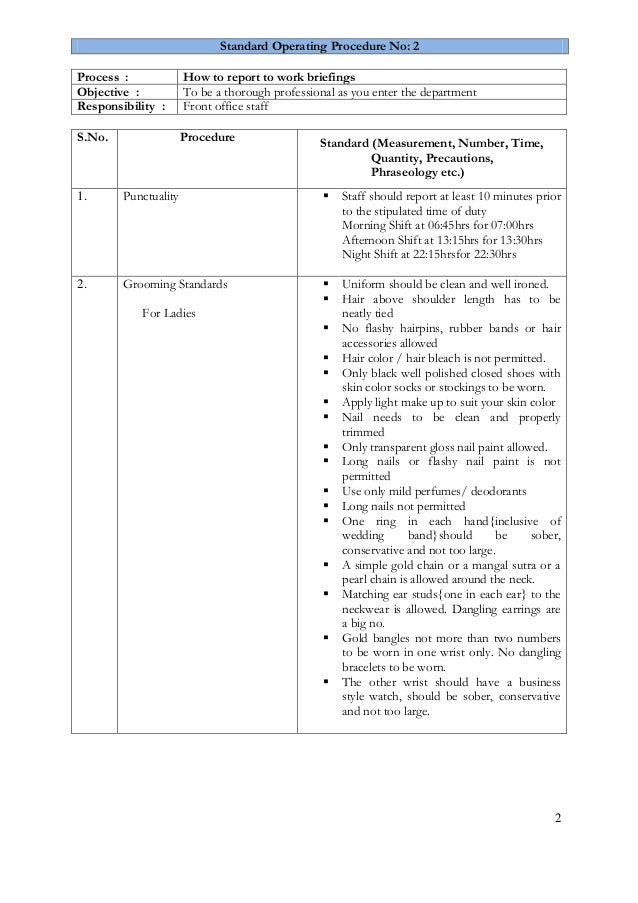A standard operating procedure (SOP) is a set of written instructions that describes, in detail, how to perform a laboratory process or experiment safely and effectively. Labs must have written SOPs when work involves the use of hazardous materials (chemical, radioactive, and biological) or physical hazards.
This SOP does not necessarily cover all possible hazards associated with the machine and should be used in conjunction with other references. It is designed to be used as an adjunct to teaching Safety Procedures and to act as a reminder to users prior to machine use. Document: SP-102-A Last reviewed: 30/07/13 STANDARD OPERATING PROCEDURE. Machine Guarding and Shop Safety Procedure. Purpose The purpose of this procedure is to minimize the risks associated with the operation of machinery and equipment by providing requirements for the protection of machine operators, shop users including students, and others who work or traverse an area with machining hazards. The purpose is also.

SOP Development
Principal Investigators or supervisors are responsible for ensuring that accurate SOPs are developed and implemented in their lab. For assistance, see the SOP Development page. The EH&S SOP template contains relevant health and safety sections.
SOP Library
EH&S has compiled a list of SOPs created and shared by ISU researchers. SOPs in the online SOP Library can be used by ISU researchers in the development of their own SOPs. Since each lab is different, researchers will need to edit the SOPs with information specific to their lab operation.
LATHE
STANDARD OPERATING PROCEDURE ‘S.O.P’
- All stock must be properly secured in the lathe chuck or mounted prior to the machining process taking place. Use the correct sized clamp or vise for the stock being machined.
- Turn the chuck or faceplate by hand to ensure there is no binding or danger of the work striking any part of the lathe.
- Check to ensure the cutting tool will not run into the chuck or lathe dog. If possible, feed away from the chuck or dogs.
- Before starting the lathe, ensure the spindle work has the cup center embedded; tail, stock and tool rests are securely clamped; and there is proper clearance for the rotating stock.
- Prior to starting the lathe, ensure that small diameter stock does not project too far from the chuck without support from the tail stock center.
- When using wood, do not mount a split work piece or one containing knots.
- When roughing stock, do not force the tool in the work piece or take too big a cut.
- The operator must always be aware of the direction and speed of the carriage or cross-feed prior to engaging the automatic feed.
- Never leave the key in the chuck. Do not let go of the key until it is free of the chuck and secured in its proper holding place.
- Select turning speed carefully. Large diameter stock must be turned at a very low speed. Always use the lowest speed to rough out the stock prior to final machining.
- The correct speed and feed for the specific material and cutting tool must be used. Stop the machine before making adjustments or measurements.
- Do not remove metal or wood chips from the table or stock by hand. Use a brush or other tool to properly remove chips or shavings from the table or stock.
- Never attempt to run the chuck on or off the spindle head by engaging the power.
- Do not stop the rotation of the chuck by reversing the power to the lathe unless tapping holes.
- Do not leave tools, bits or excess pieces of stock on the lathe bed.
Slotting Machine Tools
- All belts and pulleys must be guarded. If frayed belts or pulleys are observed, the lathe must be taken out of service and the belts or pulleys replaced.
- Stop the machine immediately if odd noise or excessive vibration occurs.
- Only properly sharpened drill bits and cutting tools in good condition should be used. Dull drill bits and chipped or broken cutting tools must be removed from service.
- Disconnect the lathe from power source and follow OSEH Guideline IHS011, Lock-out/Tag-out – Control of Hazardous Energy Sources if making repairs or servicing.
- When an operator has finished working on the lathe, and before leaving the lathe for any reason, the power must be shut off and the machine must come to a complete stop.
Cnc Slotting Machine
- When an operator observes an unsafe condition with the lathe or stock being worked, the operator must report it immediately to the designated MSSA and the lathe shall be taken out of service until the problem has been corrected.